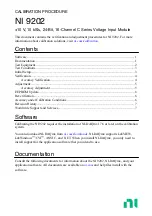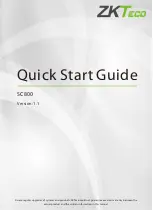
Section 8. Operation
4. Radios — A PakBus enabled radio network has an advantage over Ethernet in
that
ClockReport()
can be broadcast to all dataloggers in the network
simultaneously. Each will set its clock with a single PakBus broadcast from
the master. Each datalogger in the network must be programmed with a
PakBusClock()
instruction.
Note
Use of PakBus clock functions re-synchronizes the
Scan()
instruction. Use
should not exceed once per minute. CR1000 clocks drift at a slow enough rate
that a
ClockReport()
once per minute should be sufficient to keep clocks within
30 ms of each other.
With any synchronization method, care should be taken as to when and how
things are executed. Nudging the clock can cause skipped scans or skipped
records if the change is made at the wrong time or changed by too much.
5. GPS — clocks in CR1000s can be synchronized to within about 10 ms of each
other using the
GPS()
instruction. CR1000s built since October of 2008
(serial numbers ≥ [20409] ) can be synchronized within a few microseconds
of each other and within ≈200 µs of UTC. While a GPS signal is availa
ble,
the CR1000 essentially uses the GPS as its continuous clock source, so the
chances of jumps in system time and skipped records are minimized.
6. Ethernet — any CR1000 with a network connection (internet, GPRS, private
network) can synchronize its clock relative to Coordinated Universal Time
(UTC) using the
NetworkTimeProtocol()
instruction. Precisions are usually
maintained to within 10 ms. The NTP server could be another logger or any
NTP server (such as an email server or nist.gov). Try to use a local server —
something where communication latency is low, or, at least, consistent. Also,
try not to execute the
NetworkTimeProtocol()
at the top of a scan; try to ask
for the server time between even seconds.
8.2
Measurement and Control Peripherals — Details
Related Topics:
•
Measurement and Control Peripherals — Overview
(p. 85)
•
Measurement and Control Peripherals — Details
(p. 366)
•
Measurement and Control Peripherals — Lists
(p. 645)
Peripheral devices expand the CR1000 input and output capacities. Some
peripherals are designed as SDM (synchronous devices for measurement) or
CDM (CPI devices for measurement). SDM and CDM devices are intelligent
peripherals that receive instruction from, and send data to, the CR1000 using
proprietary communication protocols through SDM terminals and CPI interfaces.
The following sections discuss peripherals according to measurement types.
8.2.1 Analog-Input Modules
Read More
For more information see appendix
Analog-Input Modules List
(p. 646).
Mechanical and solid-state multiplexers are available to expand the number of
analog sensor inputs. Multiplexers are designed for single-ended, differential,
bridge-resistance, or thermocouple inputs.
366
Summary of Contents for CR1000
Page 2: ......
Page 4: ......
Page 6: ......
Page 32: ......
Page 36: ......
Page 38: ......
Page 40: ......
Page 60: ...Section 4 System Quickstart Figure 16 PC200W View Line Graph 60 ...
Page 96: ......
Page 98: ...98 ...
Page 302: ......
Page 453: ...Section 8 Operation Figure 115 Using the Keyboard Display 453 ...
Page 456: ...Section 8 Operation Figure 118 Real Time Custom 456 ...
Page 457: ...Section 8 Operation 8 8 1 3 Final Memory Tables Figure 119 Final Memory Tables 457 ...
Page 458: ...Section 8 Operation 8 8 2 Run Stop Program Figure 120 Run Stop Program 458 ...
Page 460: ...Section 8 Operation Figure 122 File Edit 460 ...
Page 461: ...Section 8 Operation 8 8 4 PCCard Memory Card Display Figure 123 PCCard CF Card Display 461 ...
Page 478: ......
Page 506: ......
Page 536: ......
Page 636: ......
Page 642: ......
Page 644: ......
Page 676: ......
Page 677: ......
















































